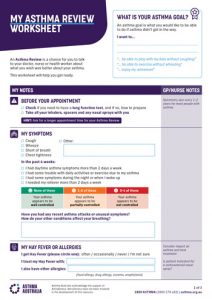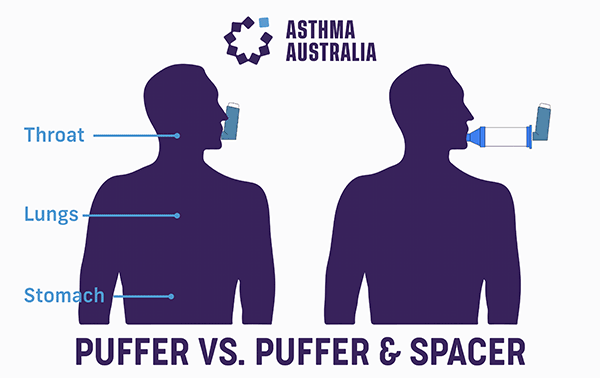Managing asthma can be very challenging and complex but we know that good asthma management leads to less asthma flare-ups and hospital visits.
To help you, we’ve narrowed down six asthma basics that you need to know. Following these steps will help you keep your asthma under control all year round.
STEP 1
Visit your doctor for an asthma review
Visit your doctor every 6 – 12 months for an asthma review. You will need to visit more regularly if your treatment has recently changed or you have been to hospital for your asthma, you are pregnant, or have severe asthma.
At your review, talk to your doctor about:
- Your current level of asthma control
- Your asthma medicines
- Your inhaler technique. E.g. do you find it difficult to use?
- Updating your Asthma Action Plan
- Your asthma triggers, allergies and hay fever
- Your flu vaccine
- Your other asthma questions
Download our Asthma Review Worksheet to help you plan your appointment.
STEP 2
Get a written Asthma Action Plan from your doctor
A written Asthma Action Plan is one of the most important things you need if you have asthma.
Everyone with asthma needs a written Asthma Action Plan.
An Asthma Action Plan is your instructions on how to manage your asthma, and what to do if you do have a flare-up or asthma attack.
Having a written Asthma Action Plan helps you self-manage your asthma. In fact, most flare-ups can be managed by following your Asthma Action Plan, saving you an extra trip to your doctor.
Follow a written Asthma Action Plan for:
- better controlled asthma
- fewer asthma flare-ups
- fewer days off work or school
- reduced reliever medication use
- fewer hospital visits
STEP 3
Preventer – take it every day, even when well
Preventers work to reduce the inflammation in the airways. Regular use of your preventer makes the airways less sensitive, which reduces the frequency and severity of asthma symptoms, overuse of your reliever medication and reduces the risk of future asthma flare-ups. Daily use of a preventer is key to keeping well.
If you don’t already have a preventer inhaler, talk to your doctor. Most adults with asthma should be prescribed one according to the National Asthma Council Australia’s Australian Asthma Handbook.
Learn more about asthma preventers here.
STEP 4
Keep an eye on your asthma control.
Many people find their level of asthma control changes with the seasons and what triggers they are exposed to, such as colds, flus and pollen. Learn about other possible triggers here.
If you have experienced any of the following in the last four weeks, there may be room for improvement in your asthma control.
- daytime asthma symptoms more than 2 days per week
- need for reliever more than 2 days per week
- any limitation on activities due to asthma symptoms
- any asthma symptoms during the night or on waking
Take the Asthma Control Questionnaire to determine your level of asthma control and discuss the results with your doctor.
STEP 5
Use a spacer and check your technique

If any of your asthma inhalers is a puffer, you should own a spacer. Spacers help your medicine get down into your lungs where it is needed. It’s especially important if you have a preventer puffer, to help avoid side-effects.
Up to 90% of people are thought to use their inhalers incorrectly[i], which means the dose of medicine isn’t getting into the lungs where it’s needed. Ask your doctor or pharmacist to check you are using your inhaler correctly.
Check your technique here: https://asthma.org.au/treatment-diagnosis/medicines-and-devices/techniques/
After using a preventer, always rinse your mouth, gargle, and spit. This also helps to avoid side-effects in your mouth from medicine left in your mouth.
If you can’t afford a spacer, contact our Asthma Educators on 1800 ASTHMA (1800 278 462) to see how they can help.
STEP 6
Learn the steps of Asthma First Aid
We’ve recently created some brand-new first aid posters to make it easier to know what to do in an emergency. There is now separate posters for those of you who use a blue/grey reliever, or one of the dual-purpose relievers.
Download the instructions you need here: https://asthma.org.au/treatment-diagnosis/asthma-first-aid/
Note: These are generic instructions only. Your doctor may give you personalised instructions on your written Asthma Action Plan to follow instead.
For more information on how to manage your asthma, call 1800 ASTHMA (1800 278 462) and speak with an Asthma Educator.
I FOLLOW THESE STEPS, BUT MY ASTHMA STILL GETS WORSE
ASTHMA BASICS FOR KIDS
To read more about asthma basics for children and how it may be different from Adults, click below
Reference:
[i] Basheti IA, Armour CL, Bosnic-Anticevich SZ, Reddel HK. Evaluation of a novel educational strategy, including inhaler-based reminder labels, to improve asthma inhaler technique. Patient Educ Couns 2008; 72: 26-33.





 1800 278 462
1800 278 462
